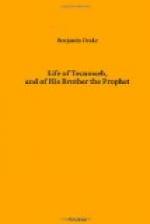movement the Indians found themselves surrounded,
on two sides, by a cordon of forts, and were threatened
with an extension of them into the very heart of their
country. They had now to choose whether they
would remove to the north and west, negociate with
the British government for the possession of their
own land, or take up arms for its defence. They
chose the last alternative; and, a war of extermination
against the English residents in the western country,
and even those on the Susquehanna, was agreed upon
and speedily commenced. Many of the British traders
living among the Indians were murdered; the forts
of Presque Isle, St. Joseph and Mackinac, were taken,
with a general slaughter of their garrisons; while
the forts of Bedford, Ligonier, Niagara, Detroit and
Pitt, were barely preserved from falling into their
hands. The contest was continued with resolute
and daring spirit, and with much destruction of life
and property, until December, 1764, when the war was
brought to a close by a treaty at the German Flats,
made between Sir William Johnston and the hostile
Indians. Soon after the conclusion of this peace
the Shawanoes became involved in a war with the Cherokees,
which continued until 1768, when, pressed hard by
the united force of the former tribe and the Delawares,
the southern Indians solicited and obtained a peace.[A]
For the ensuing six years, the Shawanoes remained
quiet, living on amicable terms with the whites on
the frontiers: in April, 1774, however, hostilities
between these parties were renewed.
[Footnote A: Thatcher’s Indian Biography.]
It is not our purpose in the present sketch of this
tribe, to present a detail of all their conflicts
with the whites; but the “Dunmore war,”
(as it is generally called,) of 1774, having been mainly
prosecuted by Shawanoes, one of their distinguished
chiefs having commanded in the battle of Point Pleasant,
and another, Puckecheno, (the father of Tecumseh,)
having fallen in this engagement, would seem to render
a full account of the border feuds of this year, not
out of place in the present narrative.
In the latter part of April, 1774, a report that the
Indians had stolen some horses, from the vicinity
of Wheeling, alarmed the whites who were making settlements
on the Ohio below that place. For greater safety
they immediately assembled on Wheeling creek, and learning
that two Indians were with some traders above the
town, they went up the river, and without stopping
to enquire as to their guilt, deliberately put them
to death. On the afternoon of the same day, they
found a party of Indians on the Ohio, below Wheeling
creek, on whom they fired, and killed several.
The Indians returned the fire and wounded one of the
assailing party. It is admitted by all the authorities
on this subject, that the two Indians killed above
Wheeling, were shot by men under the command of colonel
Michael Cresap. Mr. Jefferson, in his Notes on
Virginia, states that the second attack, in which one




